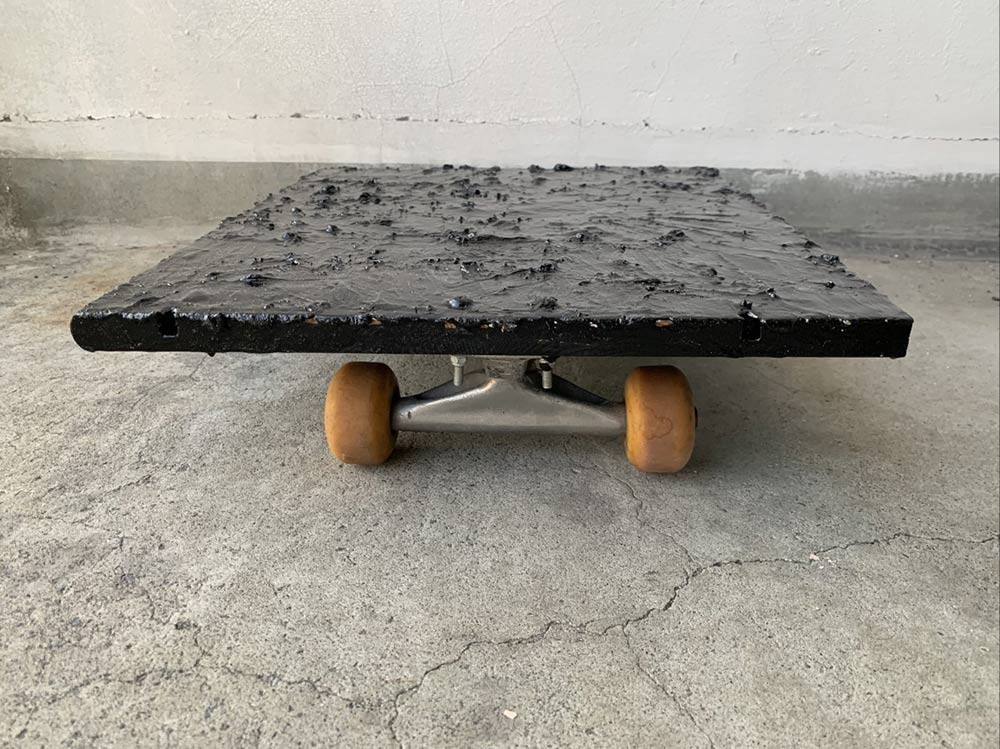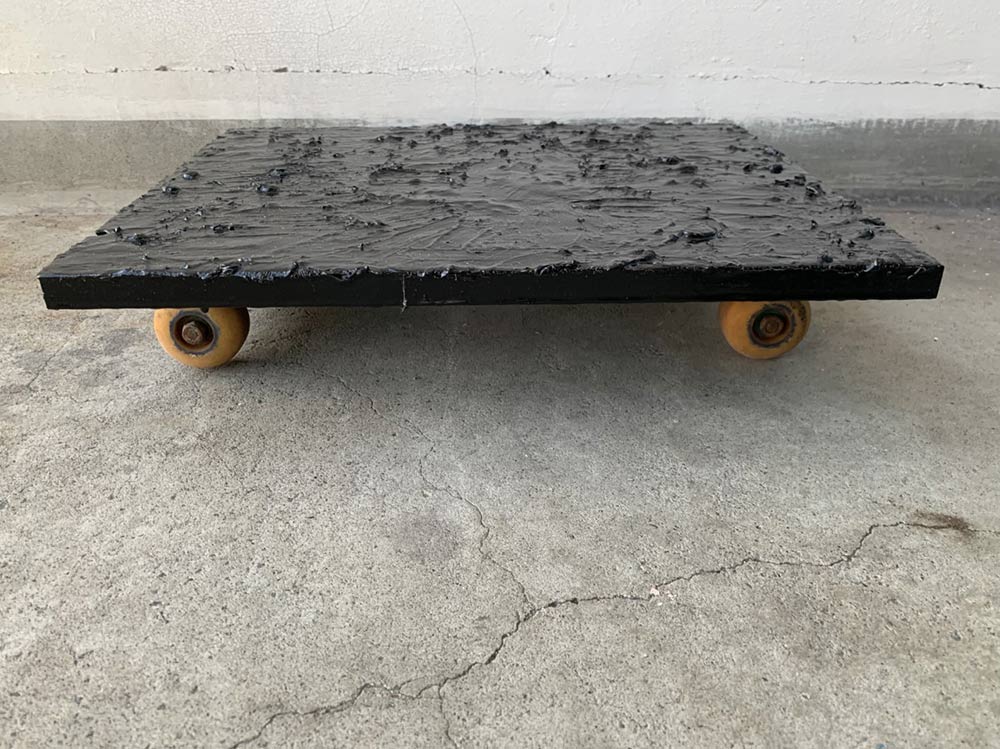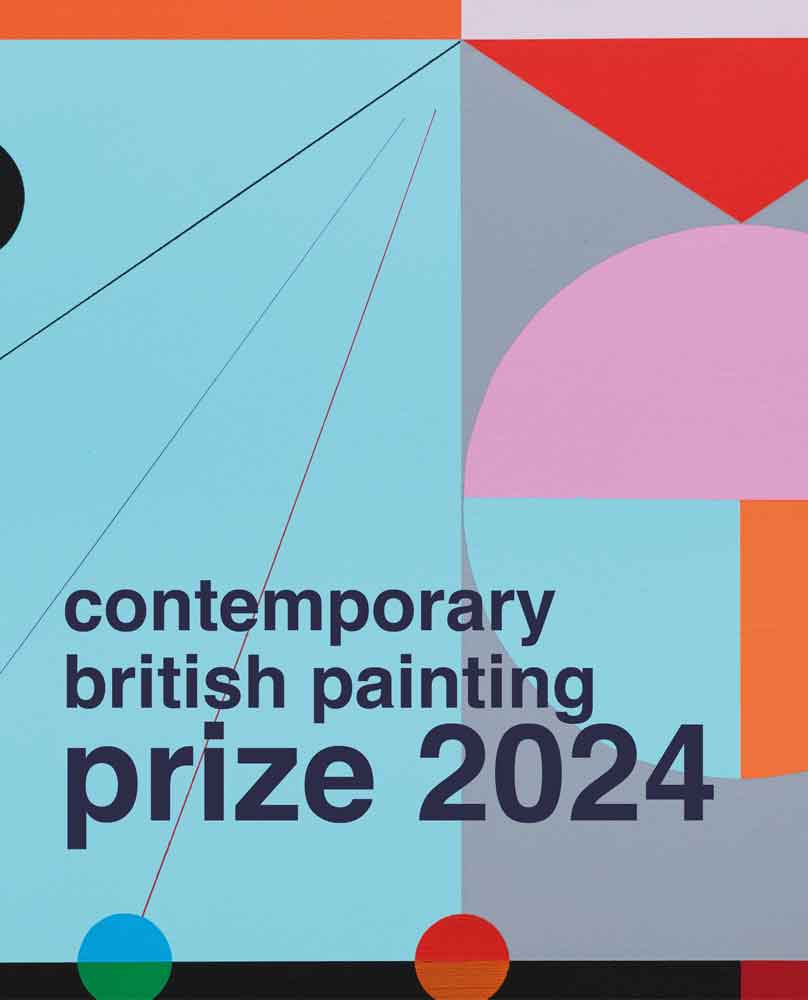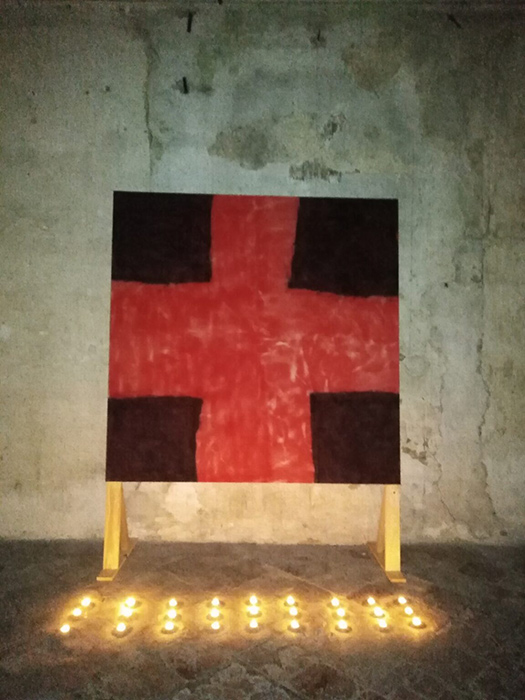Enzo Marra: Artist of the Month
Artist of the Month May 2023:
Enzo Marra, selected and interviewed by Paul Newman for CBP.
Enzo Marra’s creative practice is concerned with the direct exploration and pictorial analysis of the disparate concepts that enter his head.

CBP: Initial words in response to your recent paintings are; striking, physical and direct. It feels that the imagery is paired down to its essence as a signifier for our recognition of a motif. Can you talk about how this process of producing imagery developed in your paintings?
EM: It has taken me many years to hone down my imagery to what I am developing now. When I tired of working from photos and found imagery I moved onto quick caught sketches which then also became more direct and increasingly conjured out of my head. Still figurative even if they were in a make believe world before reducing further and further to the skeletal statements I am being drawn to. The whole process of trying to work through the concepts and ideas that arrive and finding the few that could become something more, a suitable challenge that complicates things just enough to push me on and not put me off. I have sketchpads full of ideas, too many to attempt in my lifetime, to be returned to soon or on a fortunate day in the future, their sketched presences always on page waiting to be looked at that bit closer.

CBP: The bluntness of the imagery makes me smile, particularly the dog walk and arrow paintings many of your paintings do this for me. Can you talk about the humour of your work, intentional or a natural sensibility of what you make.
EM: I don’t purposely intend for my imagery to have a humorous angle, but I have been commented on previously. I am glad that there are qualities that impart from them that I cannot guide or control. The personal reaction can vary widely, and in that moment the painting is truly alive in the viewer’s mind.

CBP: The imagery can be very stark and distilled, the surface textures very pitted and rugged. It feels like there is an urban influence, like road and people controlling signs. Is this an element that is embedded in the ideas and influences in your work?
EM: I feel drawn to materials that are not traditionally related to the art world. Materials that have a certain texture, sheen or vibrancy. Having began with enamels, I soon discovered hammerite, bitumen and fluorescent floor paints. I am still searching around the building territory, and am currently experimenting with wood filler. The way that their utilitarian ordinariness can be subverted and seen in an entirely different way, keeping me engaged irrespective of the success of each adventure. If something is not meant to be included in the recipe for an artwork, I will figure out a way for it to be there. The rawness of the revealed imagery reflected in the materials that have been utilised to bring them to life.

CBP: Some of the imagery, like the arrow studies could allude to instruction of a sign and signifier recognition. With this in mind, is there a considered relationship with language in your painting?
EM: I find that as I discover new directions to follow, each new route will involve the creation of a whole new language or a sub-division of an existing one. The process of teasing them out and following their suggestions, allowing me to create a world of my own making. Linear or blocked out, but always as direct and immediate as I can muster. The energy and confidence of the lived moment, allowing them to become an extension of idiosyncratic language or script, writ large or minutely notated, each potentially much more than it currently is.

CBP: The starkness of the black figure against a single coloured ground, like ‘Dog Walk’ triggers a connection with pioneering early 20th century abstract painting like Malevich’s Black Square paintings and the photographs of his work installed in his studio. Is there a direct nod to this painting history in your recent body of work?
EM: In my mind I can recall that image of Malevich’s Black Square paintings hung in his studio, and I certainly did paint from it in my more figurative years. I am not sure that that painting even still exists now. I try to work from the apparent purer thoughts that gestate in head, but obviously hints and suggestions will intrude in the most positive way. The directness of blackness and the presence it exerts onto the colours that share support space with it, something I am still trying to figure out today.

CBP: Your punchy and direct paintings, feel perfectly composed like they’ve landed on their canvas or board. What aspect does drawing have as developmental studies or imbedded in the painting process?
EM: Drawing is very important. The process of discovering the forms I use wouldn’t be possible without it. The whole struggle to pinpoint the immediate statement I hope to arrive at, requires endless redrawing and reinterpretation till I am sure of it. Whether it is on packaging sections, in a diary or on proper paper, the repetition makes everything much truer and more pertinent. I fill any form of blank enough book with ideas, to all be piled up ready to be rediscovered and taken further at the right time. The exploratory process of drawing, an activity in its own right and a step closer to what might be.

CBP: Where do you source your imagery from; imagination, memory, photographing, collecting?
EM: My imagery can come from diverse concepts that arrive in my head, as well as from subtle aspects of the real world that catch my eye. Chanced upon or already brewing, it needs to capture my attention enough for me to feel the need to emulate something of its energy or appearance. My imagery is alway flowing but it can take on many forms, so I am never sure on the next linearity that I will be pursuing. A single image can spawn pages of descendants, acting as stepping stones or stopping points. The activity as important as the results that it births.

CBP: Can you talk about your painting process, how you approach a session and the mediums you use?
EM: My painting process is fast but fraught. The many drawings and studies that preceded it, giving me an equally clear and impossible image to then attempt to create. The reduced nature of my work, making each and every brush stroke of that much more relevance. The role of the brush and its own particular mark making nature, then bringing its voice into the conversation that a painting is as it comes together. The equilibrium between idea and realisation, a balance that can come off perfectly or then demand a second attempt in the slightest differing way. The moment of being surprised or challenged by something of your own making, a rare sensation that only strikes when least suspected. Reminding me of what can be possible, but also of the impossibility of predicting the results of any painted attempt. The slow build up to a painting session giving me enough hope to continue and persevere, but also the fore knowledge to not expect anything to ever be any easier or more immediate. Regardless of how many years I have been toiling at this.
CBP: Dog Show which you curated this year is inspired by your own works like Dog Walk 2022. Can you talk about this project?
EM: I wanted to curate an exhibition that would have a universal theme at its core, and the idea of the dog was direct and open enough to allow the artists to not be constricted by it. The many ways that the dog is and has been seen and represented, a suitable background to then make contemporary statements from. I am glad that a large proportion of the artists included in the Dog Show, were able to do new works to be shown. Thames-Side Studios Gallery was an exceptional space to be able to present them in, at the centre of a studio complex full of energy and shared spirit. The willingness of the more established artists to be part of Dog Show, giving the final show a true mix of very different artists at very different stages of their careers. I am already toying with a form of a sequel to it, but it is still at that searching early stage. Dog Show wouldn’t have been possible without the support of Lee, Grant and Vanessa, who also exhibited alongside me. The cooperation between artists to achieve these exhibited goals, has reminded me of the comradeship that can and does bloom in our creative communities.
CBP: You presented a solo installation of cross paintings at The Church Gallery Ex Chiesa di san Sebastiano with a very different backdrop to the white wall gallery. Can you talk about how you approached this project and felt about your paintings presented in this contrasting space?
EM: I was asked to do some large scale paintings for The Church Gallery, haven’t ever attempted anything comparable in the past. My studio space wasn’t ideal but I managed to sequentially work on different sections of each over 2×2 metre expanse, using acrylic spray can which I also have little experience of. The initial idea for their development was the concept of the corner, the interaction of corners, the play of scale and juxtaposition. I didn’t even see them fully, until the folded bundle of canvas I posted through had been stretched and temporarily sat in the space. Seeing them revealed by candle light was a realisation of the most perfect way to present them. I hope I am able to work in the same way in the future. The gallery’s unconventional attitude of only allowing four visitors at any one time to experience them, is also a prompt that gives the time spent with them that bit more pertinence in those shared moments. Being able to exhibit in such an unusual space blurs the boundaries of what a gallery experience can be and gives a valued insight into the visual possibilities that are out there.
CBP: What projects are you currently working on at the moment?
EM: I am enjoying being able to concentrate on my own painting for the first time in a long while. So I am happy to have the time to try out ideas, I have only been able to sketch out so far. I have been working on how to visualise a snake in a highly geometric manner, and it is offering me many more directions than I originally anticipated. The subtle permutations offered by a linear approach, each a hoped solution to the evocation of the spirit or essence of what a snake can be, with the expected dead ends and u-turns along the taken route. It’s always good to feel a bit lost at times, whilst you figure out how you arrived there.
I have also set myself the challenge of another fortunately smaller exhibition to curate next year. It’s an interesting experience being on the other side of the gallery situation. Despite the responsibility that is knowingly self-imposed, seeing all the artworks come to life is a specific moment that you always are surprised by.
Enzo Marra’s recent projects include a solo exhibition at San Sebastian Medieval Church, Spain 2023 and a curated group exhibition Dog Show at Thames Side Studios Gallery, also in 2023
Enzo was a prize winner in the 2017 Creekside Open selected by Jordan Baseman at the APT Gallery, London, and was highly commended in the 2014 Beep Wales at the Elysium Gallery, Swansea.
Enzo has also been included in the shortlist of 427 artists for the 100 Painters of Tomorrow and has been longlisted for the Charlie Smith Anthology in 2017, the John Moores Painting Prize in 2018 and 2014, and the Beers Contemporary Award for Emerging Art in 2013, where he received an honourable mention.
The Church. Enzo Marra solo exhibition 2023 San Sebastian Medieval Church













